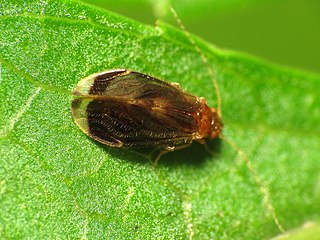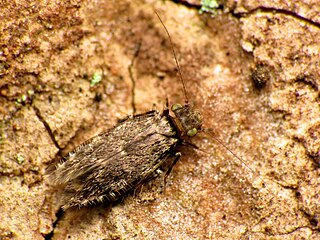
Psocoptera are a paraphyletic group of insects that are commonly known as booklice, barklice or barkflies. The name Psocoptera has been replaced with Psocodea in recent literature, with the inclusion of the former order Phthiraptera into Psocodea.

Psocomorpha is a suborder of barklice, booklice, and parasitic lice in the order Psocodea. There are more than 20 families and 5,300 described species in Psocomorpha.

Troctomorpha is one of the three major suborders of Psocodea (barklice, booklice, and parasitic lice), alongside Psocomorpha and Trogiomorpha. There are more than 30 families and 5,800 described species in Troctomorpha. The order includes parasitic lice, which are most closely related to the booklice family Liposcelididae.

Amphipsocidae is a family of hairy-winged barklice in the order Psocodea. Most species are 3.0-4.5 mm long and have many setae (hairs) on the veins and margin of the forewing. The main veins of the forewing are usually lined with two rows of setae. Like the other members of the infra-order Caeciliusetae, they have a broad, flat labrum, with well defined edges.

Peripsocidae is a family of Psocodea belonging to the suborder Psocomorpha. Members of the family are characterised by their absence of an areola postica in their wings. Many of the recently described genera are closely allied to Peripsocus. The family includes more than 300 species.

Ectopsocidae is a family of Psocodea belonging to the suborder Psocomorpha. The family includes fewer than 200 species, most of them in the genus Ectopsocus.

Homilopscocidea is an infraorder of Psocodea. It is probably a paraphyletic group, still in use for lack of a better solution. There are about 7 families and more than 1,200 described species in Homilopsocidea.

Psocodea is a taxonomic group of insects comprising the bark lice, book lice and parasitic lice. It was formerly considered a superorder, but is now generally considered by entomologists as an order. Despite the greatly differing appearance of parasitic lice (Phthiraptera), they are believed to have evolved from within the former order Psocoptera, which contained the bark lice and book lice, now found to be paraphyletic. They are often regarded as the most primitive of the hemipteroids. Psocodea contains around 11,000 species, divided among four suborders and more than 70 families. They range in size from 1–10 millimetres (0.04–0.4 in) in length.

Paraneoptera or Acercaria is a superorder of insects which includes lice, thrips, and hemipterans, the true bugs. It also includes the extinct order Permopsocida, known from fossils dating from the Early Permian to the mid-Cretaceous.
Prionoglarididae is a family of the order Psocodea that are barklice characterized by the reduction or simplification of the lacinia in adults and the specialised form of the male genitalia. It contains the only known genus of animals, Neotrogla, where females possess a penis-like organ and take on typical male sex roles.

Lepidopsocidae are an insect family of bark lice belonging to the suborder Trogiomorpha. Colloquially, Lepidopsocidae are referred to as the Scaly-winged Barklice. There are more than 220 species described worldwide. Phylogenetic DNA analysis of relationships between families in Trogiomorpha propose that Lepidopsocidae is monophyletic, meaning that the taxa within all share a common ancestor. This is supported morphologically by the presence of scales and setae covering the body and forewings of Lepodopsocids. Sister families of Lepidoposcidae include Trogiidae and Psoquillidae.

Epipsocetae is an infraorder of psocids in the order Psocodea. There are about 5 families and more than 480 described species in Epipsocetae.

Trogiidae is a family of granary booklice in the order Psocodea. There are about 11 genera and more than 50 described species in Trogiidae.
Electrentomidae is an extinct family of barklice, booklice, and parasitic lice in the order Psocodea. There are about six genera and seven described species in Electrentomidae. The family was synonymsed with the extant family Manicapsocidae in 2003 without discussion, with a prior proposal in 1972, but Azar et al., 2017, stated that "we consider herein [Electrentomidae and Manicapsocidae] apart, because a cladistic phylogenetic analysis is needed prior to taking such important decision for these groups."

Paracaeciliidae is a family of bark lice in the order Psocodea. There are about 5 genera and more than 100 described species in Paracaeciliidae.
Sabulopsocidae is a family of lice in the order Psocodea. There are at least two genera and two described species in Sabulopsocidae.
Spurostigmatidae is a family of lice in the order Psocodea. There is at least one genus, Spurostigma, in Spurostigmatidae.

Amphientometae is an infraorder of psocids, one of two major division of the Troctomorpha within the order Psocodea. There are about 7 families and at least 230 described species in Amphientometae.
Manicapsocidae is a family of Psocodea. It contains 8 extant species in 4 genera, with most of the species being found in the Neotropics, with one species in the Afrotropics. The extinct family Electrentomidae has been suggested to be a synonym of this family, though this has been considered premature by other scholars in the absence of cladistic analysis. Confirmed fossil species of the family are nearly as numerous as living ones, extending back to the Mid-Cretaceous.
Cormopsocidae is an extinct family of Psocodea. All currently known members are from the mid-Cretaceous Burmese amber of Myanmar. The family is considered either to be the earliest diverging group of the suborder Trogiomorpha, or the sister group to all other psocids, and retains many primitive characteristics.












